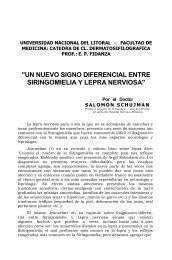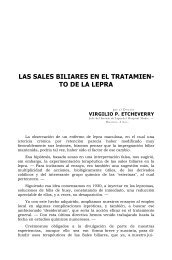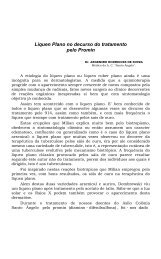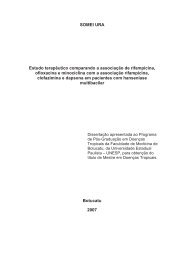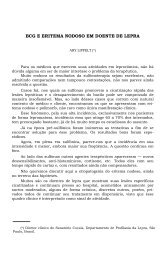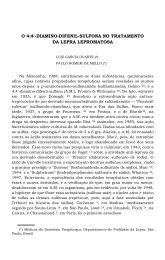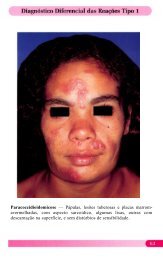Leprosy vaccines
Leprosy vaccines
Leprosy vaccines
You also want an ePaper? Increase the reach of your titles
YUMPU automatically turns print PDFs into web optimized ePapers that Google loves.
CONVIT, J. et al. <strong>Leprosy</strong> <strong>vaccines</strong><br />
of transmission. More specifically, the degenerative<br />
phenomena observed in more than 50% of the genes of<br />
armadillo-derived M. leprae (COLE, 2001) may be very<br />
similar to the phenomena in classically transmitted M. leprae,<br />
where the bacilli are clearly adapted to the intracellular<br />
environment The bacilli involved in community transmission<br />
might conserve a greater genomic integrity, since they are<br />
perhaps less dependent on the intracellular environment and<br />
more flexible in surviving under diverse environmental<br />
conditions. Comparative studies of these two forms of bacilli<br />
may be of exceptional interest<br />
Undoubtedly many subclinical or undetected cases of<br />
leprosy may be sources of new infections, which may not<br />
become evident for many years. The possibility also exists<br />
that some cases treated with MDT could still be sources of<br />
new infections. In a single report, relapses have been<br />
reported in 20% of patients with multibacillary leprosy after<br />
MDT treatment (JAMET, 1995). Epidemiological studies of the<br />
frequency of new cases in the residences of treated patients,<br />
particularly among children born after the completion of<br />
treatment, might be of interest<br />
To return to the issue at hand, careful and<br />
uninterrupted use of MDT for 20 years has profoundly<br />
affected the prevalence of leprosy throughout the world, but<br />
the detection of new cases has not shown a similar impact<br />
This suggests the need for additional control measures to<br />
consolidate the gains that have been achieved (CONVIT,<br />
2000). Since substantial interruption of transmission does not<br />
seem to be an option at present, we are confronted with the<br />
very real need for the development of an effective protective<br />
vaccine. There is important evidence available at present<br />
regarding the preventive effect of several candidate<br />
<strong>vaccines</strong>. It would seem appropriate to dedicate part of the<br />
effort and financial resources available for leprosy, which are<br />
clearly limited, to the development of a vaccine to prevent<br />
infection, even when the sources of transmission may<br />
persist This position is reinforced by the epidemiometric<br />
models of leprosy developed by several investigators<br />
(LECHAT, 1977), where the introduction of a preventive<br />
vaccine in the model shows an impressive improvement in<br />
control of the disease.<br />
Immunologic Considerations for<br />
a Potential Candidate Vaccine<br />
There is substantial evidence indicating that a Th1<br />
immune response is one of the factors associated with<br />
resistance to leprosy. Positive delayed-type hypersensitivity is<br />
one the manifestations of Th1 activity associated with<br />
variable degrees of resistance during the natural course of the<br />
disease.<br />
The adjuvant effect of BCG as a stimulus of Th1<br />
responses is widely recognized. BCG stimulates granuloma<br />
formation and the synthesis of pro-inflammatory cytokines.<br />
Immuno-stimulatory CpG sequences were first recognized in<br />
BCG and other mycobacteria (TOKUNAGA, 1999). At<br />
present, BCG is perhaps the most acceptable Th1 adjuvant<br />
available for use in humans. It shares common antigens with<br />
M. leprae. Its routine application by the intradermal route<br />
seems particularly suitable for the induction of Th1<br />
responses, perhaps in part because of the accessibility of<br />
appropriate antigen-presenting cells.<br />
Two decades ago, research on the immunological<br />
response to M. leprae across the human spectrum of disease<br />
was very active. At present these lines of research are<br />
relatively inactive except in countries such as Brazil and<br />
India, as well as relatively isolated laboratories in other parts<br />
of the world. The most recent reports of the WHO advisory<br />
committee on the elimination of leprosy have pointed out<br />
that many groups which were previously active in leprosy<br />
research have moved on to other areas of investigation. We<br />
still do not know with certainty which are the protective<br />
antigens of M. leprae, or whether the protection may occur<br />
under some circumstances and in some individuals, but not<br />
in others. There is evidence that Th1 and Th2 responses are<br />
not clearly associated with resistance and susceptibility,<br />
respectively. The current situation partially reflects the<br />
extraordinary emphasis placed on early detection and<br />
prompt application of MDT as control measures. If we accept<br />
the possibility of transmission in pre-clinical stages of<br />
infection during a period which may extend for years and<br />
recognize the limitations in our knowledge of possible modes<br />
of transmission which may not even involve human contact,<br />
the limitations of MDT in elimination of leprosy as a public<br />
health problem become apparent Definitive eradication<br />
doesn't appear to be an option with this strategy. This<br />
uncertainty occurs precisely at a time when increasingly<br />
powerful tools are available to the medical sciences for the<br />
development of new and more effective <strong>vaccines</strong>.<br />
We might consider the great contrast that exists at<br />
present between research in leprosy and tuberculosis.<br />
Obviously the massive expansion of tuberculosis and the high<br />
mortality associated with the disease are contributing factors<br />
in the orientation of research efforts. Nevertheless, the efforts<br />
devoted to the development of an effective vaccine are<br />
impressive ( BRENNAN, 2001; DOHERTY, 2002; YOUNG,<br />
2002). Clear objectives have been defined, including the<br />
evaluation of new attenuated strains and of strains that carry<br />
genes for the synthesis of immuno-stimulatory cytokines, as<br />
well as the development of subunit <strong>vaccines</strong> to be<br />
administered, if necessary, with powerful adjuvants and of<br />
DNA <strong>vaccines</strong>. If we consider the substantial evidence of<br />
protection against leprosy afforded by BCG (CONVIT, 1956;<br />
CONVIT, 1993; PONNIGHAUS, 1992), it is possible that one<br />
or more of these new tuberculosis <strong>vaccines</strong> may provide even<br />
greater cross protection against M. leprae than BCG<br />
has.<br />
Where feasible, evaluation of that possibility should be<br />
Hansen. Int., 28(1) 13-18, 2003<br />
15





